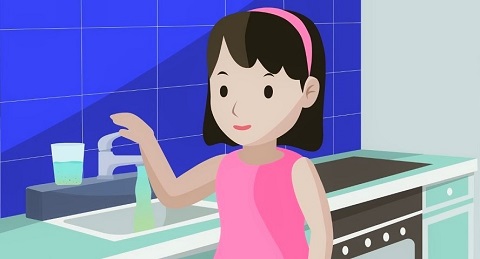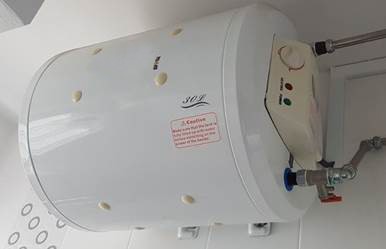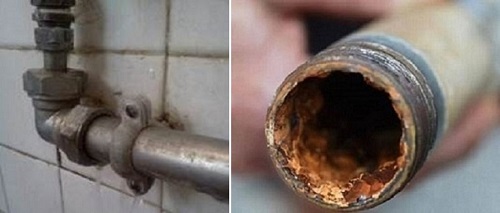Drinking water is normally clear but very occasionally may appear discoloured or contain particles. This may be caused by essential maintenance operations such as the routine cleaning of water tanks, flushing of service pipes in buildings and testing of fire hydrants. However, there are some instances where discoloured water can occur as a result of internal fittings and installations in our homes.
Water video "What causes tap water to appear brownish?" >>
Here are some common questions asked regarding water quality.
1. Why do customers sometimes encounter discoloured water?
Common causes of discoloured water occur due to maintenance operations such as routine cleaning of water tanks and the flushing of service pipes in buildings. Some other reasons why discoloured water can occur include:
-
Corrosion of iron tank and other components in storage type hot water heater possibly due to end of service life or quality issues
- Corroded service water pipes and fittings
-
Stagnant water in service pipes and water service installations from infrequent use (i.e. owners returning from a holiday
-
Heavy drawoff from a watermains leak resulting in resuspension of mineral sediments

"Storage type" Hot Water Heater

Corroded service pipes
2. What should customers do when they encounter discoloured water?
The first thing that customers can do is to run their taps and flush any water tanks inside their premises until the water runs clear. While doing so, avoid using the water for laundry or any other purposes. If the water has not cleared up after 10 to 15 minutes, customers can call PUB’s hotline at 1800-CALL-PUB for assistance with their water supply.
Customers should also try to determine the source of the discoloured water. For example, is the discoloured water only localised to a single appliance or from the hot water taps/showers? If it is, this could indicate a faulty hot water heater or appliance.
3. What does PUB do to resolve an incident of discoloured water?
We will investigate and determine the likely cause and source of the discoloured water within PUB’s water mains. Depending on our findings, we will conduct emergency pipeline operations and isolate the source to prevent further discolouration.
If the discolouration comes from PUB’s water mains, temporary water supply, such as water bags, will be provided for the customers affected. In more serious cases, water wagons will be deployed. To clear brownish water from PUB’s water mains, our officers will flush the water containing re-suspended mineral sediments out from the water mains in a controlled manner until the water clears up.
However, if the source of discoloured water is within the customer premises (E.g. faulty or corroded water tank), we will advise the customer to rectify the problem by replacing or repairing the appliances or pipes.
4. What can the customer do to prevent discoloured water?
As discoloured water can occur as a result of internal fittings, customers can do their part by ensuring that corrosion resistance materials are used for their service pipes. Customers should also frequently check that their appliances are in good working condition and replace them when there are signs of corrosion or when it has passed its service life stipulated by the supplier.
5. Is discoloured water safe for drinking?
The common cause for temporary discolouration of your tap water is due to the re-suspension of mineral sediments inside the pipe. These sediments form over time when naturally-occurring minerals in tap water settle at the bottom of the pipes, especially when the water in the pipes is slow-moving. Discolouration could have also been caused by other issues and if you do observe discolouration in the water, please let the tap run until it is clear before drinking the water. If the water has not cleared up after 5 to 10 minutes, customers can call PUB’s hotline at 1800-CALL-PUB for assistance with their water supply.
6. Does PUB attend to every case of discoloured water?
Feedback on discoloured water will be investigated thoroughly to establish the cause and ensure that PUB’s water supply is clean and clear. We also work very closely with our customers, Town Council and Building Maintenance Team to ensure that the water is fit for potable use within WHO guidelines.
7. What is PUB doing to prevent future incidents from occurring?
PUB engineers study and operate the water distribution network carefully during emergency and maintenance pipeline operations to prevent sudden changes in flow direction. This helps to minimise discoloured water incidents.
We also engage the Town Councils and SCDF regularly to ensure that their maintenance operations are conducted with care to minimise discoloured water incidents. In addition, PUB send out an annual circular to Town Council, Management Corporation Strata Titles (MCSTs) and building owners of their responsibility to ensure the proper security and maintenance of their water service installations including their potable water storage tanks.
Customers could also play their part by paying attention to their service pipes and appliances and ensure they are in good working condition. If water in their service pipes or water heater has been stagnant for a long period of time, they should flush before using the water, especially for potable use.
8. Why do customers occasionally see pink stains in the wash basin or bathroom?
The pink stains observed on surfaces (e.g. toilet bowls, sink drains and bathroom tiles) are typically caused by the naturally occurring bacteria,Serratia, which is found in the environment and not from the water or water mains, and do not pose health concerns.
The Serratia bacteria thrives in moist or dusty conditions, especially in places that are newly renovated or close to construction activities. It is also easily carried by air and seeks out moist locations, such as wash basins and bathrooms.
Regular cleaning of surfaces and keeping them dry can help to control the growth of these bacteria and prevent pink stains from forming.
